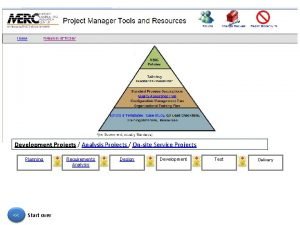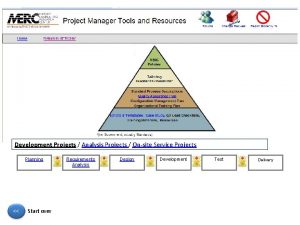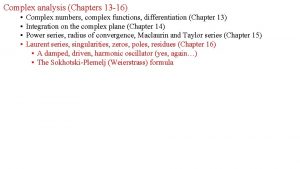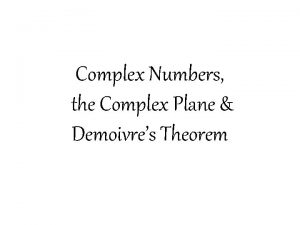MS Project Management Development of Complex Projects Course








































- Slides: 40

MS Project Management & Development of Complex Projects Course Code - 706 Analytical Hierarchy Process Multi-criteria Decision Making Lecture # 14

Summary of Previous Lecture In previous Lecture, we have discussed about Ø Ø Ø Ø Ø Definition of communication & communication management Relevance of communication Purpose of communication Basic communication model Shortcoming in communications Communication lines Challenges in communication Communication management framework Communication methods

Analytic Hierarchy Process The Analytic Hierarchy Process (AHP), is a procedure designed to quantify managerial judgments of the relative importance of each of several conflicting criteria used in the decision making process.

Case Study Designer Metro must decide which of three manufacturers will develop his "signature“ toothbrushes. Three factors are important to Metro: (1) his costs; (2) reliability of the product; and, (3) delivery time of the orders. The three manufacturers are Medicam Industries, Reach, and Oral B. Medicam will sell toothbrushes to Metro for Rs 100 , Reach for Rs 80 , and Oral B for Rs 144.

Analytic Hierarchy Process Step 1: List the Overall Goal, Criteria, and Decision Alternatives

Example: Metro n Hierarchy for the Manufacturer Selection Problem Overall Goal Select the Best Toothbrush Manufacturer Criteria Cost Reliability Delivery Time Decision Alternatives Medicam Reach Oral B

Analytic Hierarchy Process ------- For each criterion, perform steps 2 through 5 ------- Step 2: Develop a Pairwise Comparison Matrix Rate the relative importance between each pair of decision alternatives. The matrix lists the alternatives horizontally and vertically and has the numerical ratings comparing the horizontal (first) alternative with the vertical (second) alternative. Ratings are given as follows:

Analytic Hierarchy Process • Step 2: Pairwise Comparison Matrix (continued) Compared to the second alternative, the first alternative is: rating extremely preferred very strongly preferred moderately preferred equally preferred Numerical 9 7 5 3 1

Analytic Hierarchy Process • Step 2: Pairwise Comparison Matrix (continued) Intermediate numeric ratings of 8, 6, 4, 2 can be assigned. A reciprocal rating (i. e. 1/9, 1/8, etc. ) is assigned when the second alternative is preferred to the first. The value of 1 is always assigned when comparing an alternative with itself.

Pairwise Comparison Matrix: Cost Metro has decided that in terms of price, Reach is moderately preferred to Medicam and very strongly preferred to Oral B. In turn Medicam is strongly to very strongly preferred to Oral B.

Pairwise Comparison Matrix: Cost • Since Reach is moderately preferred to Medicam, Medicam's entry in the Reach row is 3 and Reach's entry in the Medicam row is 1/3. • Since Reach is very strongly preferred to Oral B, Oral B's entry in the Reach row is 7 and Reach's entry in the Oral B row is 1/7. • Since Medicam is strongly to very strongly preferred to Oral B, Oral B's entry in the Medicam row is 6 and Medicam's entry in the Oral B row is 1/6.

Pairwise Comparison Matrix: Cost Medicam Reach Oral B Medicam Reach 1 3 1/6 1/3 1 1/7 Oral B 6 7 1

Analytic Hierarchy Process Step 3: Develop a Normalized Matrix Divide each number in a column of the pair wise comparison matrix by its column sum.

Normalized Matrix: Cost Divide each entry in the pairwise comparison matrix by its corresponding column sum. For example, for Medicam the column sum = 1 + 3 + 1/6 = 25/6. This gives: Medicam Reach Oral B 6/25 18/25 1/25 Reach 7/31 21/31 3/31 Oral B 6/14 7/14 1/14

Analytic Hierarchy Process Step 4: Develop the Priority Vector Average each row of the normalized matrix. These row averages form the priority vector of alternative preferences with respect to the particular criterion. The values in this vector sum to 1.

Priority Vector: Cost The priority vector is determined by averaging the row entries in the normalized matrix. Converting to decimals we get: Medicam: (6/25 + 7/31 + 6/14)/3 =. 298 Reach: (18/25 + 21/31 + 7/14)/3 =. 632 Oral B : ( 1/25 + 3/31 + 1/14)/3 =. 069

Analytic Hierarchy Process Step 5: Calculate a Consistency Ratio The consistency of the subjective input in the pairwise comparison matrix can be measured by calculating a consistency ratio. A consistency ratio of less than. 1 is good. For ratios which are greater than. 1, the subjective input should be re-evaluated. ------- For each criterion, perform steps 2 through 5 -------

Determining the Consistency Ratio • Step 1: For each row of the pairwise comparison matrix, determine a weighted sum by summing the multiples of the entries by the priority of its corresponding (column) alternative. • Step 2: For each row, divide its weighted sum by the priority of its corresponding (row) alternative. • Step 3: Determine the average, max, of the results of step 2.

Determining the Consistency Ratio • Step 4: Compute the consistency index, CI, of the n alternatives by: CI = ( max - n)/(n - 1). • Step 5: Determine the random index, RI, as follows: Number of Alternative (n) 3 4 5 Random Index (RI) 0. 58 0. 90 1. 12 Number of Alternative (n) 6 7 8 • Step 6: Compute the consistency ratio: CR = CI/RI. Random Index (RI) 1. 24 1. 32 1. 41

Checking Consistency • Multiply each column of the pairwise comparison matrix by its priority: . 298 1 3 1/6 1/3 +. 632 1 1/7 6 +. 069 7 1 • Divide these number by their priorities to get: . 923/. 298 = 3. 097 2. 009/. 632 = 3. 179. 209/. 069 = 3. 029 = . 923 2. 009. 209

Checking Consistency • Average the above results to get max = (3. 097 + 3. 179 + 3. 029)/3 = 3. 102 • Compute the consistence index, CI, for two terms. CI = ( max - n)/(n - 1) = (3. 102 - 3)/2 =. 051 • Compute the consistency ratio, CR, by CI/RI, where RI =. 58 for 3 factors: CR = CI/RI =. 051/. 58 =. 088 Since the consistency ratio, CR, is less than. 10, this is well within the acceptable range for consistency.

Pairwise Comparison Matrix: Reliability Metro has determined that for reliability, Medicam is very strongly preferable to Reach and equally to moderately preferable to Oral B. Also, Oral B is strongly preferable to Reach.

Pairwise Comparison Matrix: Reliability Medicam Reach Oral B 1 1/7 1/2 Reach 7 1 5 Oral B 2 1/5 1

Normalized Matrix: Reliability Divide each entry in the pairwise comparison matrix by its corresponding column sum. For example, for Medicam the column sum = 1 + 1/7 + 1/2 = 23/14. This gives: Medicam Reach Oral B 14/23 2/23 7/23 Reach 35/41 1/41 Oral B 2/8 5/8 1/8

Priority Vector: Reliability The priority vector is determined by averaging the row entries in the normalized matrix. Converting to decimals we get: Medicam: (14/23 + 35/41 + 2/8)/3 =. 571 Reach: ( 2/23 + 5/41 + 5/8)/3 =. 278 Oral B: ( 7/23 + 1/41 + 1/8)/3 =. 151 • Checking Consistency Metro’ responses to reliability could be checked for consistency in the same manner as was cost.

Pairwise Comparison Matrix: Delivery Time Metro has determined that for delivery time, Medicam is equally preferable to Oral B. Both Medicam and Oral B are very strongly to extremely preferable to Reach.

Pairwise Comparison Matrix: Delivery Time Medicam Reach Oral B 1 1/8 1 Reach Oral B 8 1 1/8 1

Normalized Matrix: Delivery Time Divide each entry in the pairwise comparison matrix by its corresponding column sum. Medicam Reach Oral B 8/17 1/17 8/17 Reach 8/17 1/17 8/17 Oral B 8/17 1/17 8/17

Priority Vector: Delivery Time The priority vector is determined by averaging the row entries in the normalized matrix. Converting to decimals we get: Medicam: (8/17 + 8/17)/3 =. 471 Reach: (1/17 + 1/17)/3 =. 059 Oral B: (8/17 + 8/17)/3 =. 471 • Checking Consistency Metro’ responses to delivery time could be checked for consistency in the same manner as was cost.

Pairwise Comparison Matrix: Criteria The accounting department has determined that in terms of criteria, cost is extremely preferable to delivery time and very strongly preferable to reliability, and that reliability is very strongly preferable to delivery time.

Pairwise Comparison Matrix: Criteria Cost Reliability Delivery 1 1/7 1/9 Reliability Delivery 7 1 1/7 9 7 1

Normalized Matrix: Criteria Divide each entry in the pairwise comparison matrix by its corresponding column sum. Cost Reliability Delivery 1/17 63/79 9/79 7/79 Reliability 49/57 7/57 1/57 Delivery 9/17 7/17

Priority Vector: Criteria The priority vector is determined by averaging the row entries in the normalized matrix. Converting to decimals we get: Cost: Reliability: Delivery: (63/79 + 49/57 + 9/17)/3 = ( 9/79 + 7/57 + 7/17)/3 = ( 7/79 + 1/57 + 1/17)/3 = . 729. 216. 055

Analytic Hierarchy Process Step 6: Develop a Priority Matrix After steps 2 through 5 has been performed for all criteria, the results of step 4 are summarized in a priority matrix by listing the decision alternatives horizontally and the criteria vertically. The column entries are the priority vectors for each criterion.

Overall Priority Vector The overall priorities are determined by multiplying the priority vector of the criteria by the priorities for each decision alternative for each objective. Priority Vector for Criteria [. 729. 216. 055 ] Cost Medicam Reach Oral B . 298. 632. 069 Reliability. 571. 278. 151 Delivery. 471. 059. 471

Analytic Hierarchy Process Step 7: Develop a Criteria Pairwise Development Matrix This is done in the same manner as that used to construct alternative pairwise comparison matrices by using subjective ratings (step 2). Similarly, normalize the matrix (step 3) and develop a criteria priority vector (step 4). Step 8: Develop an Overall Priority Vector Multiply the criteria priority vector (from step 7) by the priority matrix (from step 6).

Overall Priority Vector Thus, the overall priority vector is: Medicam: (. 729)(. 298) + (. 216)(. 571) + (. 055)(. 471) =. 366 Reach: (. 729)(. 632) + (. 216)(. 278) + (. 055)(. 059) =. 524 Oral B: (. 729)(. 069) + (. 216)(. 151) + (. 055)(. 471) =. 109 Reach appears to be the overall recommendation.

Summary of This Lecture In this Lecture, we have discussed about Ø Ø Ø Ø Ø Definition of AHP & Use of AHP in decision making AHP Process Goal, Criteria & Alternative listing Pair wise Comparison matrix Develop a normal matrix Develop the priority vector Calculate consistency ratio Develop a priority matrix Develop an overall priority vector

End Note “The greatest Discovery of our generation is that a human being can alter his life by altering his attitudes” William James

THANK YOU!
 Pearl oyster white elephant bread and butter
Pearl oyster white elephant bread and butter Digitization workflow
Digitization workflow Traditional project management vs modern project management
Traditional project management vs modern project management Gstm university of pretoria
Gstm university of pretoria Project management crash course
Project management crash course Bsb51407
Bsb51407 Software project objectives
Software project objectives Initiating and planning systems development projects
Initiating and planning systems development projects Project identification and selection process
Project identification and selection process Initiating and planning systems development projects
Initiating and planning systems development projects Simple compound complex and compound-complex sentences quiz
Simple compound complex and compound-complex sentences quiz Droplet infection
Droplet infection Quiz on simple compound and complex sentences
Quiz on simple compound and complex sentences Oedipus complex and electra complex
Oedipus complex and electra complex Sigmund freud psychoanalytic theory
Sigmund freud psychoanalytic theory Sublimation defense mechanism
Sublimation defense mechanism Half brick wall in stretcher bond report
Half brick wall in stretcher bond report Course title and course number
Course title and course number Course interne course externe
Course interne course externe Telecom risk management
Telecom risk management Cost management in agile projects
Cost management in agile projects 4 p's of project management in software engineering
4 p's of project management in software engineering Pmcd framework
Pmcd framework The role of project management in achieving project success
The role of project management in achieving project success Process discriminants in software project management
Process discriminants in software project management How to reduce project duration
How to reduce project duration Introduction to project management kathy schwalbe
Introduction to project management kathy schwalbe Software project evaluation
Software project evaluation Types of project audit in project management
Types of project audit in project management Microsoft project agile
Microsoft project agile Types of project termination in project management
Types of project termination in project management A supervisor's guide to safety leadership
A supervisor's guide to safety leadership Asset management vs project management
Asset management vs project management Configuration management system pmp
Configuration management system pmp Cost management principles
Cost management principles Software configuration management diagram
Software configuration management diagram Project integration management example
Project integration management example Complex care management toolkit
Complex care management toolkit Pyramid levels of management
Pyramid levels of management Top management middle management first line management
Top management middle management first line management Top management and middle management
Top management and middle management
































































